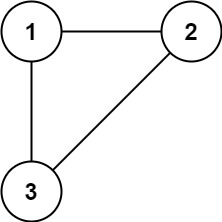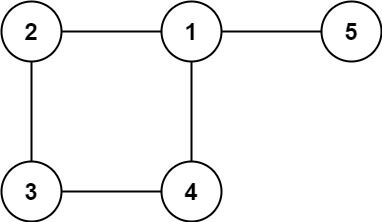Description
In this problem, a tree is an undirected graph that is connected and has no cycles.
You are given a graph that started as a tree with n nodes labeled from 1 to n, with one additional edge added. The added edge has two different vertices chosen from 1 to n, and was not an edge that already existed. The graph is represented as an array edges of length n where edges[i] = [ai, bi] indicates that there is an edge between nodes ai and bi in the graph.
Return an edge that can be removed so that the resulting graph is a tree of n nodes. If there are multiple answers, return the answer that occurs last in the input.
Example 1:

Input: edges = [[1,2],[1,3],[2,3]] Output: [2,3]
Example 2:

Input: edges = [[1,2],[2,3],[3,4],[1,4],[1,5]] Output: [1,4]
Constraints:
n == edges.length3 <= n <= 1000edges[i].length == 21 <= ai < bi <= edges.lengthai != bi- There are no repeated edges.
- The given graph is connected.
Solution
Python3
class DSU:
def __init__(self, n):
self.parent = [i for i in range(n)]
self.rank = [0 for _ in range(n)]
def find(self, x):
if self.parent[x] == x:
return self.parent[x]
self.parent[x] = self.find(self.parent[x])
return self.parent[x]
def union(self, u, v, pu, pv):
# pu = self.find(u)
# pv = self.find(v)
if (pu == pv): return
if self.rank[pu] < self.rank[pv]:
pu, pv = pv, pu
# ensure self.rank[pu] >= self.rank[pv]
self.parent[pv] = pu
if self.rank[pu] == self.rank[pv]:
self.rank[pu] += 1
class Solution:
def findRedundantConnection(self, edges: List[List[int]]) -> List[int]:
N = len(edges)
uf = DSU(N + 1)
for a, b in edges:
pa, pb = uf.find(a), uf.find(b)
if pa == pb:
return [a, b]
else:
uf.union(a, b, pa, pb)
return []